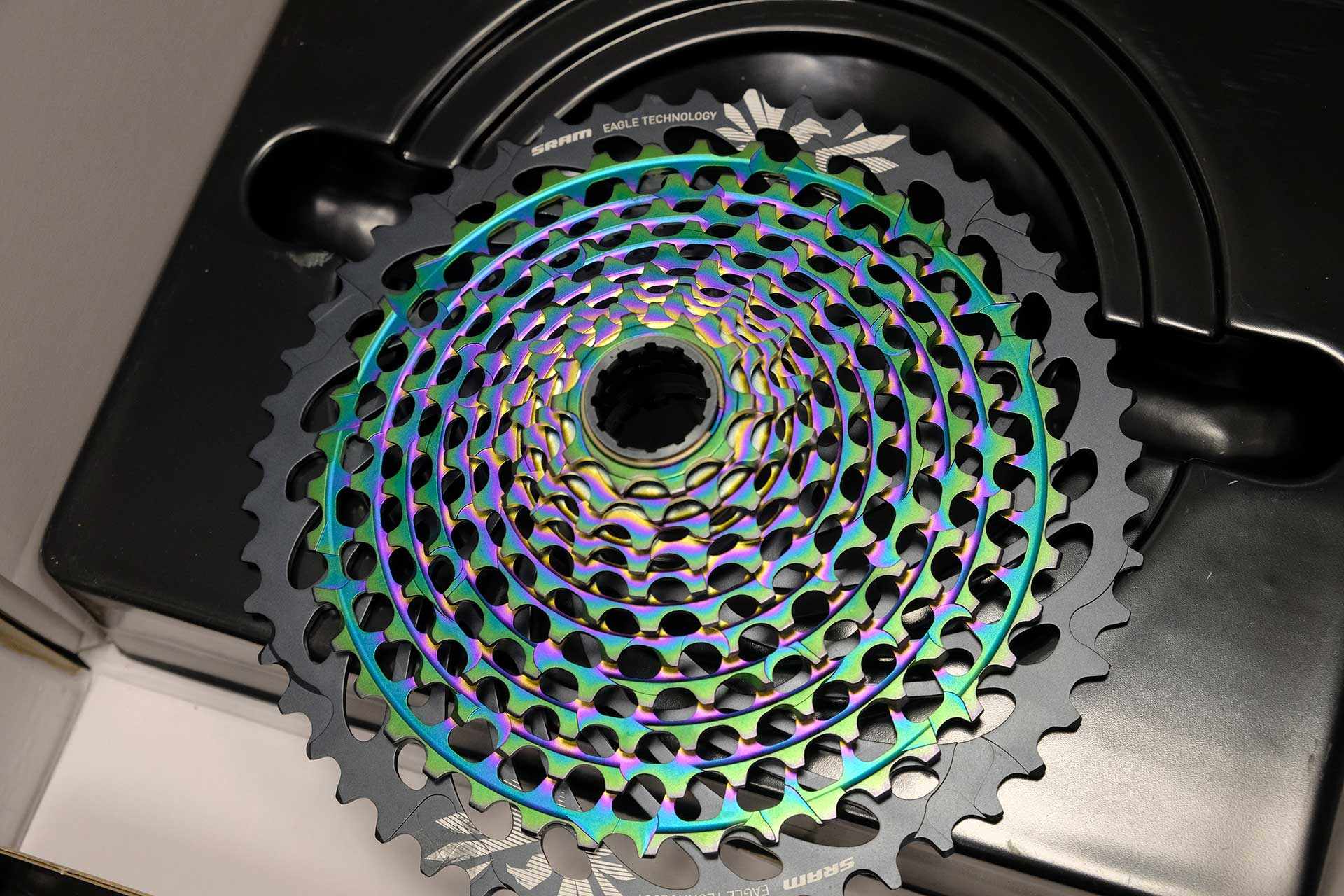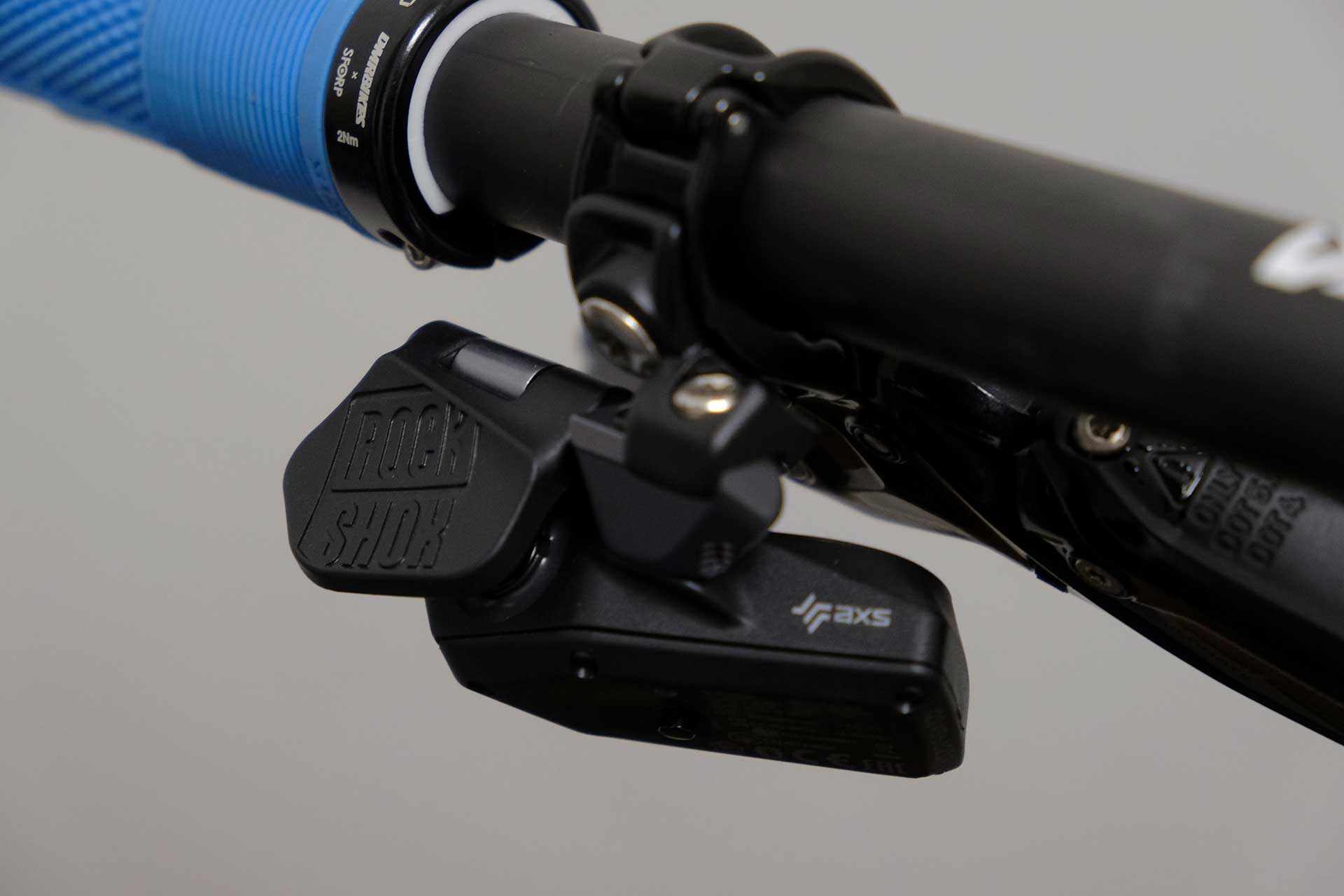David tests out the flagship SRAM AXS Eagle XX and X01 groupsets – will the wireless drivetrain stun him with its performance?
Historically, I’m not a fan of mixing mountain bikes and electronics, but I have ended up riding AXS Eagle more than probably anyone else in the office. I’ve now ridden it on three bikes: The oh-so-pretty rainbow XX1 on A Yeti SB130 that SRAM got to us earlier in the year to try out; for most of Autumn, X01 on a Nukeproof Mega 275C, and finally, on Chipps’ super fancy Ibis Ripley Mk. 4.
I’ll tell you what I thought later; first, let’s take a look at the individual components.
Oh, and it’s SRAM AXS like ‘access’ and not A. X. S. like some boy band. You know, like it gives you access to your gears. Like that…
AXS Granted
Working from the bars back, the SRAM AXS Eagle shifter is different to what you may expect. A single paddle has a lip at the bottom and a ramp at the top. By default, pushing either of those will shift up and down, but it’s a button press rather than a lever push. If you want a comparison on feel: slightly firmer than a button on an arcade machine, but not by much.
The button pushes are the same way around as a normal shifter: push at the bottom to move the chain up the cassette, push at the top to move to a smaller sprocket. The button also wraps around to the front of the shifter, built so pushing it with an index finger there also activates a shift to a smaller sprocket.
All of this can also be reprogrammed in the app, though the front and upper buttons on a right hand shifter can only do the same thing as each other. The shifter itself takes a CR2032 watch battery, and SRAM quote a battery life of 25 hours from one. 25 hours of use, that is, not nearly-one-a-day. I didn’t have to change any over the months I spent testing AXS Eagle-equipped bikes. The shifters are motion sensitive and go to sleep to conserve battery life.
Going further back from here… no, further, there are no cables… yep, bit more, all the way to the back of the bike, there, there’s the mech. Magic, and a painless journey to the rear axle with absolutely no cable routing to deal with.
The rear mech is much like other Eagle mechs, but with a techy oblong hump sticking off the back, which is the battery. Like all electronic derailleurs, it makes cool cyber noises from the future. Unlike the shifter battery, this is a proprietray SRAM one moulded to fit. It contains a 300mAh (milliamp hours) charge, and SRAM quotes the battery life as up to 12 months (we presume that means a charged battery sat on a shelf).
The charger is a tiny little thing that runs off a micro-USB lead. I guess USB-C would have been more up to date, but most households probably have spare micro-USB leads around these days. If you’re doing a long trip, spare batteries and the charger are extremely pocketable. It will charge from a USB power bank.
Now the non-electrical bits: Like a lot of SRAM cassettes, this one is a thing of beauty with plenty of light showing through once you look beneath the teeth. In X01 flavour, it has a love-it-or-hate-it rainbow oil slick finish, and pairs with a matching chain.

The chainring and carbon cranks run on a DUB bottom bracket, and seem very similar to SRAM’s previous offerings of this ilk – though I’m sure someone will point out the exact differences. About 4.99mm (compared to GXP) if I recall correctly.
Finally, there’s an app. I hate apps. The SRAM AXS one is pretty painless, though not packed with features. Mostly you just get to assign button functions, and check battery status. Even doing a firmware update for the mech was relatively painless. If I’m going to pick on one thing, it’s that battery indicators in the app are very small, and slightly buried.
More on later experiences with the app below, but for now, I’m going to interview Chipps, starting with fitting it.
A Second Opinion
David Hayward: How does fitting SRAM AXS Eagle compare to fitting a normal drivetrain? Are the mechanical components much different?
Chipps Chippendale: Not really. It’s simple enough that it all makes sense, but you still need to do a bit of research to make sure that you’re doing it correctly. This video is essential viewing:
I also got caught out by not fitting the 4mm plastic washer that goes outboard of the DUB BB bearings and wondering why it didn’t all work. It’s best to make sure you’ve completely read up on everything before you start. As far as I could see, there are no ‘quick setup’ guides with the components or a ‘Start here’ URL with every component like the BB or chain.

DH: What other steps are there to set it up?
CC: Everything is pretty familiar – like setting chain length, B-tension and set-limit-screws, but the way in which they’re all done can be different, so again it needs some research. For example, you’re unlikely to work out how to adjust the derailleur trim level on your own. Pairing the components too, is simple once you know how, but hard to work out at first.
DH: What do you think of having a drivetrain that needs an app?
CC: I’m not really a fan, because of the time it takes to fire up the app, wake the components, sync everything together, upload new firmware (on occasion) – it can all really annoy you if you just want to check the battery level… (I’ve since learned that you can rely on the colour of the AXS LEDs to give you a full/half/empty readout – which is only as accurate as the app ever is, so that’s a bonus)
Talking of the app, I’ve used it to swap the roles of my shifter buttons on the side of a trail in Wales, which was surprisingly easy. No laptop needed, no phone signal, just a phone.
DH: What about having batteries that need charging?
CC: The batteries are all long-lasting enough that you can take them for granted. This does make eventually finding your bike is flat before a ride particularly shocking. However, spare batteries are reasonably cheap and light – and a quick charge is usually enough to revive a flat battery while your mates are still drinking coffee and chatting. Generally, if you can remember to charge a phone and a Garmin, you’ll be just fine.

DH: How do you find it in use?
CC: There’s no denying it – It just works. It’s simple and quick, to the point that you forget (or it simply doesn’t matter) that there are no wires connecting everything. The AXS Reverb is particularly speedy in operation – way quicker than the lever equivalent when you take into account thumb and lever travel and speed of operation. The gears, in contrast are no quicker than cables, so apart from frame cleanliness, I don’t feel they actually do anything better. Battery life as mentioned, is long enough that you don’t really think/worry about it. And while you do worry about having an expensive derailleur hanging off your bike, such is the luxuriant burden of being a Formula1-level early adopter of technology.
DH: Is there anything you’d change about the design or how it works?
CC: I’d like some different options for paddle shapes. I think that the finger/under-bar (rather than the thumb) operation of the right hand lever doesn’t offer the same operation as SRAM’s cable shifters do. Some different bolt-on lever options might be good to try. For instance, the left paddle isn’t as dished as the right hand paddle. It would have been nice to have a twin rocker paddle for the left hand shifter too for maximum customisation. I’m also sad for frames that have lovely organic moulded-in cable ports that are now redundant and ugly looking…
DH: Who and what do you think SRAM AXS Eagle is for?
CC: It’s primarily for pro-racers and rich folks. It doesn’t really do anything that cables and hoses don’t do. However, for bikes with awkward cable routing – especially for droppers, then fitting it is wonderful. You only install it once, though, so that benefit soon wears off. I think you’re either a rider who loves tech (and remembering to charge things) or you’re not. And if you are, then it’s as good as you want it to be.
AXS Denied?
This drivetrain needs an app. I hate apps, but quite liked this one… at first.
Inital setup is a breeze, apart from the minor annoyance of having to create a SRAM account to use it. There seems to be no way to set it up without doing this. There are occasional connectivity annoyances, but that seems to be inherent to anything that uses Bluetooth.

Months later, seconds before heading out the door, I wanted to check the battery level on the rear mech. Compressing this as much as possible: logged out due to app update, password apparently wrong, password mananger phone/computer file conflict fixed, but retained incorrect password. For Reasons I’d have to get the laptop out to do a password reset, so I attempted to use the option to create a new account through Facebook instead, which didn’t work either thanks to a two factor authorisation failure that day.
At this point I notice two things: I only have an hour of daylight left, and, if you scroll down on the app login screen, there’s a hidden “continue as guest” option. Which, helpfully, just reloaded the login screen. At which point I threw my arms up and rushed out not caring if the battery ran out or not. I can push it up hills.
When the app works it’s absolutely fine. By tying hardware to software though, particularly app stores and data collection, manufacturers are tying their products to an ecosystem with many potential points of failure.
AXS Land
The shifter ergonomics of AXS Eagle may bother some people, but not me. They’re certainly different to the paddles of a typical cabled shifter. I quite like the feel of the paddle, as my thumb nestles in it well, but if you’re expecting something akin to normal shift levers, it’s really not.
Chipps dislikes how different the AXS Eagle shifters are to SRAM’s mechanical shifters. If you swap between bikes a lot, that might be an issue, but for most of us it isn’t. If I switch between AXS and non-AXS bikes, it can take a few shifts for my brain to recalibrate, but after that it never bothers or catches me out.

Battery life is good. The Yeti SB130 came with three batteries: one for the mech, one for the wireless Reverb seatpost also fitted to it, and one spare. Out of habit, I tended to leave one charging and swap them out after rides. I needn’t have though, as subsequently only having one battery with the Nukeproof Mega 275C was no impediment to riding. The battery is small enough that it’s easy to pop off the mech and charge, and I would do it every few rides only to find it still had loads of juice left. Generally, it never took more than half an hour to get back to a full charge.
Mechanically, the batteries seem to be sound too: as the scratches on the derailleur attest, this AXS had an absolute battering from Calderdale and everything stayed put. Speaking of which, the mech has an Overload Clutch built in to detect crashes and protect it. The clutch disengages to protect the motor, but it also lets the mech move out of harms way before returning to its last position. It seems to work.

In my life, I have destroyed precisely one rear mech (so far). At the time it was the most expensive one in the world, and one of a handful in the country. In 2020, the most expensive mech in the world is probably this one, and there’ve been a few times I winced after hearing it hit rocks. So far, it’s pleasingly robust.
In terms of shifting performance, AXS Eagle shifts are as clean as you’d expect for such a premium drivetrain. On the Yeti and Ibis, I needed to index it once on each bike (which is done with a series of button pushes to enable ‘micro-adjusts’ – Google this instead of ‘indexing’ if you need to do it). Once that was done, I didn’t have to touch it again. This is better performance than most cabled gears I’ve run.

I’ve ridden the Nukeproof for longer. It arrived properly set up and shifting well, and despite plenty of coatings of Pennine filth, I’ve not had to touch it, it just keeps on shifting well. It’s not fully magic, as the chain and cassette will still rust a little if someone puts the bike away wet after washing… some scrubbing and lube saw it right just like any others though.
People tend to worry about wireless shifting; pretty much the first thing anyone says to me about an electronic drivetrain is “I bet it’s been hacked already”. I’m yet to hear of such a thing happening with this or Di2. Communications between the AXS Eagle shifter and mech are encrypted, and in the months I’ve used this, it hasn’t missed a beat. No missed shifts, no mis-shifts, nothing unexpected at all. I’ve not tried riding it through a busy RF (radio frequency) environment such as London Bridge Station in rush hour, or an NEC exhibition hall… but us mountain bikers tend not to be in the most complex wireless environments anyway, do we?

That said, if you can get physical access to the AXS buttons on the mech and shifter, that seems to be all you need to do to pair it with any smartphone, so there’s opportunity for some skullduggery. Taking turns on the Ibis, Chipps and I have had some very mild conflict over which controls should do what, leading me to surprise him with gearshifts, and him to surprise me with unexpected dropper movement.

Chipps also pointed out to me how easy it is for the gear shifter buttons to get pressed by movement on a bike rack, or in the back of a van, and the only way to stop this potentially draining a battery would be to remove it. Perhaps AXS batteries will be the new thing people accidentally leave in trail centre car parks.
Overall
Furious as I am at the encroachment of computers and electronics into mountain bikes, on the trail I’ve found it impossible to dislike AXS. It’s well designed and does what it should, very well. The premium price means it’s definitely not for everyone, but it is a reliable, smooth and dare I say simple drivetrain.
For more on SRAM’s AXS Eagle, have a look at www.sram.com/en/sram/mountain/collections/eagle-axs




































And in five years’ time you’ll need to keep an old phone running an old OS to run the old app that SRAM no longer support to manage your now ‘ancient’ AXS version 1 drivetrain.
You don’t need to use the app at all. I run AXS on all of my bikes and haven’t even downloaded the app. You just fit it and it works. Simples.
And if you need an indication of battery charge, just press the button on the mech and the little led will glow either green, amber or red. Simple.
Personally I have to applaud SRAM fornpushing the envelope in engineering terms, people never knew they wanted such tech until Shimano and SRAM introduced it.
You also have to applaud the early adopters as without them the trickle down effect simply won’t happen, as for the haters and doubters, if companies stood still and failed to push the envelope in terms of product development and accessibility then we would all be riding triple chain ringed clunkers from the 80’s, every company gives us choices, Good, Better, Best and Luxe, you decide your budget and buy accordingly, simples.
I have to say it’s fabulous – I have it on 2 out of 4 bikes, soon to be 3 of 4. I’m keeping the 4th bike old school though as I have a pile of spare gear cables and fittings to work through
That dropper battery is right in the line of fire off the back tyre.
I also love it, especially the futuristic whizz with each gear shift. But as good as it is the jockeys still succumb to ice the same as non electronic mechs 🙂
“I also love it, especially the futuristic whizz with each gear shift. But as good as it is the jockeys still succumb to ice the same as non electronic mechs ”
Not in Arizona!!
I’m sold on AXS and taking the plunge with an upgrade kit. The only thing that stings is that AXS is considerably cheaper on the continent. Even factoring exchange rates, it feels pricey in the UK.